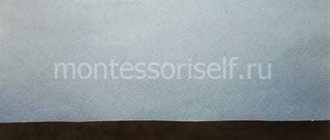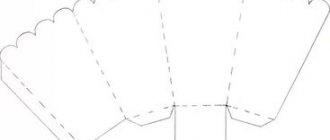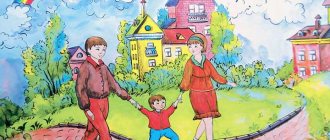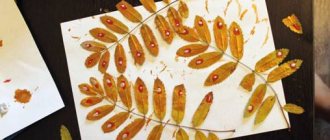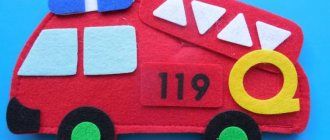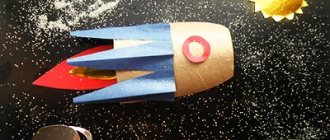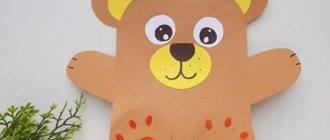Tasks. Teach children to cut out houses from paper folded like an accordion or twice in half. Improve the technique of cutting with scissors: by eye in a straight line (walls of houses), along an oblique (roofs) and along folds (windows). To develop compositional skills - when creating a panorama of the city, rhythmically arrange houses in rows, starting from the top and partially overlapping the images.
Preliminary work. In independent artistic activity, a small group of children prepares the basis for a future composition - they tint a large sheet of paper or a strip of wallpaper, dividing the space into two parts (2/3 - green or yellow-brown ground; at the very bottom two stripes of a gray road, separated by white markings; 1/3 - blue or dark blue sky - see figure). A city tour or looking at illustrations and postcards with city panoramas.
Materials, tools, equipment. Strips of colored paper of different widths for cutting out buildings, rectangles and strips of colored paper for cutting out windows, simple pencils, scissors, glue, glue brushes, oilcloths, napkins, paper and cloth, a large sheet of paper or a strip of wallpaper to create an overall composition.
Contents of the lesson.
The teacher shows the children the basis for the future composition, explains that now there is space - the earth (the bottom of the sheet) to the horizon (holds his hand, showing the horizon line) and the sky. But soon, soon houses here will rise to the very sky, people will live in the houses, cars will run along the roads... And you and I will do this. Let's create our own city. The city is big, there are also a lot of houses in it. Now I will show you how you can create a big beautiful house.
— I want to build a brick house, so I’ll take an orange sheet. My house will have 2 floors, so I will fold the paper in half. I'll turn it around, you see - this is the first floor, and this is the second. How many entrances will there be in my house? Let's see. I'll fold the paper in the other direction - first in half, and then in half again. I'll unfold it. Help me count the entrances: one, two, three, four - four entrances in total. I'll fold the porches again and cut out the roofs - like this - I cut off a corner on one side, and then on the other. Let me turn it around and it turns out to be a house with a figured roof. Now we need to make the windows. I take a narrow strip of yellow paper. I fold it in half and in half again, smoothing out the fold. I unfold and cut exactly along the folds so that the windows turn out the same. I put up windows on the house. You see, there are not enough windows. I take another strip of paper, a different color (for example, blue, pink) and make exactly the same windows. I lay out the windows, alternating them by color or just as if the light is on in some windows and not in others (or the curtains are pink, blue, green) and glue them. This needs to continue until there is one window in every room of my house - on every floor, in every entrance. I will continue cutting out windows when you start making your houses.
The teacher invites one child to show the children how to make a house, clarifies and comments on his actions so that the children reinforce the idea and repeat the sequence again.
Children independently choose the color of paper for their house and windows. They start cutting. The teacher helps with advice and completes his work, and also cuts out round dances of men (ribbon applique) in order to interest the children in another new way, which they will master in the second half of the school year. Children transfer the houses to the general panorama. The teacher helps place them and explains that first we need to glue the houses on the horizon line, and then lower the next rows lower and lower. Partially overlaying the house on the house, we have a road below, cars will rush along it, which we will cut out on the next lesson.
After class. The composition “Our City” is hung for general review and discussion.
Summary of direct educational activities on the application “Festive City”
Olga Pronina
Summary of direct educational activities using the application “Festive City”
Summary of direct educational activities on artistic creativity “ Festive City ”
Pronina O. V. middle group No. 12 “Kapitoshka”
OO Artistic Creativity
1. Develop the creative abilities of preschoolers using non-traditional types of appliqué .
2. Develop artistic taste and sense of composition.
3. Develop a desire to interact with peers when creating collective compositions.
4. Develop fine motor skills of the hands.
5. Cultivate love for your hometown .
OO Reading fiction
6. Learn to listen carefully to a poem.
Material. Whatman paper, which depicts an unfinished picture of the city , brushes, rags, stands for brushes, semolina, ready-made samples of houses , glue, rags for glue, jars for semolina, photographs of the city . the noise of the city in the recording .
Preliminary work. Looking at illustrations about the city , reading fiction.
Group work: Application and drawing “Festive fireworks” for City Day in the middle group
Ksenia Kapitanios
Group work: Application and drawing “Festive fireworks” for City Day in the middle group
Goal: development of creative abilities in children
Contribute to the creation of a collective composition , conveying impressions of the holiday ( fireworks )
.
Continue to develop your ability to work with paper
Develop a sense of color, aesthetic perception, fine motor skills of the fingers, a sense of composition.
Strengthen the skills of accurate gluing and complete drawing of parts of the human body (head, face, arms, legs, hair)
Evoke feelings of joy from the result obtained.
Ready-made forms from colored paper for houses (buildings, windows, human forms (children, adults)
glue, brushes, whatman paper with a background of sky, earth and
fireworks .
Preliminary work :
City Day” was held using ICT, where children were introduced to the history of the city , looked at illustrations, and watched a video about the city .
Victory Day! Drawing "Spasskaya Tower". Application “Festive fireworks” On the eve of the celebration of Victory Day, we in the senior group decided to combine two areas of creativity: application + drawing, and what of that. Collective work “Festive fireworks” senior group. “Festive fireworks” There are festive fireworks in the sky, Fireworks here and there. The whole country congratulates the Glorious Veterans. And the blooming spring gives them. Collective work “Victory Salute” There are festive fireworks in the sky. Fireworks here and there. The whole country congratulates the glorious veterans, and the blooming spring gives them tulips... N. Ivanova. Collective work “Victory Salute” (photo report) There are many holidays in our country today, but the greatest is only one, and it is unlikely that anyone will challenge its primacy. It's May 9th. Team work in the middle group. Application with drawing elements “In a sunny meadow” In the spring, all the children are already waiting for summer, warmth, and sun. Since all the children really wanted summer, I suggested depicting their sun, their common one. Collective work in the middle group “Carpet for hedgehogs” (application with drawing elements) Drawing: “Autumn carpet for hedgehogs” Purpose: To teach children to draw leaves using the “print” technique: apply paint to the leaves, trying to shape them. Collective work “Winter Forest”. Non-traditional drawing using ICT in the middle group Synopsis of the educational activity “Winter Forest” in the middle group on “Artistic Creativity” (drawing a landscape using non-traditional techniques) p.Summary of educational activities for children of the first junior group on artistic and aesthetic development (drawing) “Festive fireworks” Program content: 1. Teach children to draw using an unconventional technique with “fingers” (fireworks lights). 2. Learn to complete the drawing yourself.
Abstract of educational activities in non-traditional techniques (blowing) “Festive fireworks” in the middle group Objectives: To introduce the method of drawing using the “blowing” technique. To improve the ability to correctly use the color palette: yellow,.
GCD move
Children stand near the teacher. The audio recording contains the noise of the city .
V-el. Guys, what noise do you think it makes?
Children. This is the noise of the city .
V-el. If we listen to the noise of the city , what sounds will we hear?
Children. The noise of cars, the voices of people, the rustling of trees, etc.
V-el. Guys, what is the name of our city ?
V-el. In our corner there are many photographs about our city . Let's look at them.
Children approach the patriotic corner.
V-el. Look at our city . What surrounds us in the city ?
Children. Residential buildings, kindergartens, schools, shops.
V-el. Our city is very beautiful . holidays will we have ?
Children. Spring Festival and May 9th .
V-el. For the holiday, the city is decorated to make it even more beautiful.
When we have a holiday , what does mom wear for the girls? (beautiful dress, ties a bow, puts on beads and earrings)
.
What about the boys? (ties or bow tie, suit)
.
Let's make our city beautiful , festive , decorate it so that all the people who live in our city enjoy the holiday .
Now we will make a big picture with our festive city .
Children approach the table on which there is a painting with a partial image of the city .
V-el. Look how beautiful the picture is. What's missing from it?
V-el. Now we will make beautiful houses from multi-colored semolina.
Children sit at tables, smear the houses with glue and sprinkle them with multi-colored semolina. After completing the work, a physical minute is held.
There is a house in a clearing,
Well, the way to the house is closed
We open the gates
We invite you to this house.
Children come up to the picture and stick it at home. It turns out to be a city .
V-el. What else do we need to do to make our city beautiful ?
Children. Make flower beds.
v-fir. We will make flower beds of different colors.
V-el. And now we will decorate our beautiful city with balloons to make it even more beautiful and launch them into the sky.
Children stick balloons.
V-spruce. Look what a beautiful, festive city it turned out to be . And now the children will read a poem about our city .
Source
Lots of new opportunities for creating unusual masterpieces of paper applique!
Master class on applique from natural material “Gift for Dad” with children 5 years old
Goal: to develop in children the ability to make a gift for dad for Defender of the Fatherland Day using
appliqué using natural materials.
Educational objectives: teach children of the middle group to select small pebbles of approximately the same size and stick them on them. Application in the senior group “Spring Bouquet” Tasks. Teach children to cut out flowers (tulip corollas)
and leaves from
paper squares and rectangles folded in half; show different techniques for decorating a flower (applique , spreading, mosaic, drawing spots and veins. Learn to create a collective one.
Publication “Applique using foam rubber.”
Probably all teachers know that during art classes it is interesting for children, so that their faces radiate joy and their eyes glow with delight. How to achieve such an effect? Experience shows that one of the most important conditions for the successful development of children.
Paper applique. Ideas for children's creativity
It is not for nothing that applique has become one of the most favorite types of decorative and applied art used in working with children. This is not only exciting and entertaining for the children, but also has a beneficial effect on the development of their mental and creative abilities.
Do you want to make your activities with children using paper appliqué even more diverse, unusual and interesting? Then we are pleased to invite you to a special section of the MAAM portal dedicated to applique in all its types, techniques and manifestations! In it you will find a great variety of ideas for original crafts, lesson notes, and step-by-step master classes. In a word, there is a wide scope for your and your children’s inspiration!
